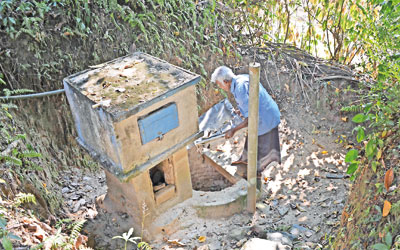
Despite nationwide drought disaster, no emergency
An elderly resident in Hemmathagama, Aranayake looks down a well that has run dry. Pix by Saman Wijeya Bandara
By Anushiya Sathisraja
In twenty three out of the 25 districts of Sri Lanka, people are crying out for water, farmlands are parched and indebted farmers are facing long-term financial ruin. The country’s economy will weaken by a percentage point, an international rating agency has warned, while also noting that the debt-laden island’s fiscal deficit target will not be met.
More than a million people are suffering, especially in the main rice-growing districts including Anuradhapura, Polonnaruwa and Kurunegala.
But the island will not declare a state of emergency because the tourism industry could be affected, Disaster Management Minister, Anura Priyadharshana Yapa, told the Sunday Times, adding that relief programmes are continuing, he said.
“5,000 water tanks and 250 tractor mounted bowsers have been requested by the ministry. The Disaster Management Center has ordered 50 tractor mounted bowsers separately, which have been already distributed to Gampaha and Kurunegala districts. We plan to distribute others shortly,’’ he said.
To avert food shortages, 250,000 metric tonnes of rice are being imported, he said.
Colombo will not face a water shortage because of the high levels of water in the Kelani River, but he warned that sea water is flowing into the river.
A report by the UN Food and Agriculture Organization says 15 per cent of the rice harvest will be lost this year. The overall paddy harvest is likely to be lowest for three years and vegetable prices have increased sharply in the past three months.
Professor Anthony Norbet of the Colombo University’s Department of Geography said efforts should be made to improve the people’s ability to cope with the effects of the drought. He suggests cultivating crops such as kurakkan that requires less water.
Subsistence paddy farmers who depend on minor irrigation, make up the majority of people hit by the drought.
Gradually declining rainfall over the last four years in combination with the lower Maha and Yala harvest of recent years, have left them progressively poorer.
Despite intermittent rains last week, 18 districts are badly affected and worse, including food shortages, are feared.
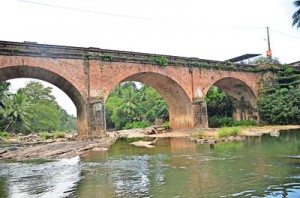
Disaster Management Centre figures reveal that 303,000 families comprising more than a million people are experiencing an acute water shortage. The Northern Province is the hardest-hit with 411,796 people suffering.
All districts in the North, Vavuniya, Mullaitivu, Mannar, Killinochchi and Jaffna are experiencing the severe dry spell; with the most affected being the Jaffna district’s Delft (4,586), Kayts (3,553), Maradankulam Karainagar (10,500), Telippalai (10,172), Chavakachcheri (24,024) and Chankanai (7,445) areas.
The second largest number of people affected are in the Western Province 407,600, while 67,442 are affected in Minuwanagoda. In Divulapitiya, and Katana 61,140 and 27,051 are suffering, respectively.
Sri Lanka relies heavily on seasonal monsoon rains for water. And as a result of poor monsoons over the past two years as well as weak rainfall in the early months of this year, reservoirs, ponds and wells have dried up.
Studies suggest that while there have been alternate dry and wet spells over the past three decades, the frequency of drought years has been increasing.
Weather experts also say there is a need for further study to address this issue since the South Asian region is set to face severe drought spells for the next three decades.
The constant cooling of the atmosphere over Central Asia has been cited as one of the main reasons for frequent drought years in the country, Lalith Chandrapala, the director general of the Department of Meteorology said.
Due to the atmospheric disturbance in the vicinity of Sri Lanka showery conditions are expected to continue during next few days, particularly today.
Cloudy skies along with showers or thundershowers can be expected at times over Eastern, Northern North Central and Uva provinces and Hambantota district. Showers or thundershowers will occur elsewhere particularly after 2.00pm.
Fairly heavy showers (of about 75 mm) are also likely at some places. There may be temporary localised strong winds during thundershowers.
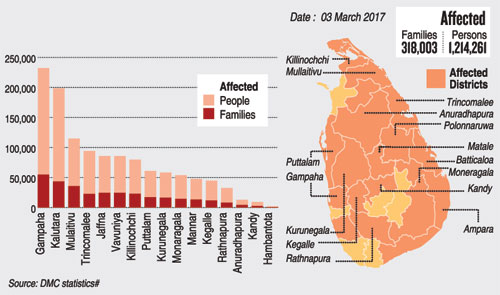
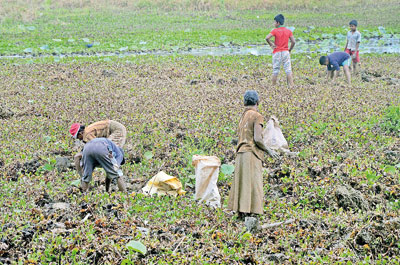

From a transit compound for animals to the birth of our zoo
The fact that the Zoo exists is due to the curiosity of Europeans in the 19th century about the animals of tropical lands that they read about in explorers’ and colonisers’ accounts. Elephants, leopards, crocodiles, dragons … all sounded so incredible, they had to be seen to be believed. As some pioneer animal collectors discovered, there was money to be made in capturing wild animals in the tropics and sending them to Europe where people would pay to see them on display.
Sri Lanka became Europe’s source of animals for zoos and circuses as a result of the efforts of two men, both German. This country was actually the leader in the conservation of natural resources, regarding them as assets. The world’s first fauna and flora sanctuary was established at Mihintale in the 3rd century BC by King Devanampiyatissa (250-210 BC).
In modern times, the opening of National Parks at Yala in a protected area of 979 sq km and Wilpattu with an area of 1,316 sq km in February 1938 was a conscious effort to protect the many species, especially elephants and leopards, living within them. Up to then, jungle animals were considered as “game” to be shot, not as food but as trophies. The government-run National Zoological Gardens had been opened to the public two years earlier to give people a chance to see wild animals in a mock jungle habitat; to marvel at them just as people did at zoos in Europe.
However, the opening of the Zoo was not a deliberate plan of the government. It happened because of the bankruptcy of the private company that created and owned a depot in Dehiwala where wild animals from Sri Lanka, and in transit from India and East Asia to Europe, were caged.
The capture and collecting of wild animals in a professional way was begun in the island colony at the beginning of the last century by a settler from Germany, John Hagenbeck (1866-1940). He was the half-brother of Carl Hagenbeck (1844-1913) who became famous in Europe as an animal dealer and zoo creator.
John and Carl were the sons of Gotfried Claes Carl Hagenbeck (1810-1887), who was a fishmonger in Germany with a part time business in buying and selling exotic animals. John settled in Ceylon in 1891 when he was 25, attracted – like many Europeans – to the island by the profits to be made from being a tea planter.However, he was persuaded by his brother Carl to capture animals in Ceylon and ship them to him in Germany.

He did so enthusiastically sending an early shipment of wild animals that included 67 Ceylon elephants. This enabled Carl to start the world’s first open-plan zoo at Stellingen, near Hamburg in 1907. Following the success of this, other countries wanted animals and John Hagenbeck obliged, finding a plentiful supply in this country where wild animals were considered an annoying impediment to the progress of colonisation. He also arranged to import animals from other countries and in the 1920s established a transit compound on 11 acres of land he bought in what was then jungle wilderness near Dehiwala.His success resulted in the start of various Hagenbeck circuses and zoos around the world, as well as being the beginning of the National Zoological Gardens.
The second German enters the scene then in the shape of a forgotten pioneer, a German zoologist called Heinz Randow. His activities only came to light when he wrote a book, published in English in 1958, about his adventures in this country 35 years before. It is an astonishing, as well as entertaining book called Zoo Search in Ceylon. It was published with a dramatic cover showing a snarling tiger.
Not much is known about Heinz Randow, apart from what he cares to reveal in his book which defines him as fearless in his pursuit and care of wild animals, while appreciating the luck that saved him many times from being killed by beasts, snakes or scorpions. The remarkable composure shown by the author in trying circumstances is evident from the book’s beginning, when he states: “John Hagenbeck picked me out of the crowd of passengers leaving the ship, drove me by car from Colombo in a southerly direction towards Dehiwala.
“The plan was to set up there a collecting station for animals and later, perhaps, even a zoo…Beyond Wellawatte we went across broken country through coconut groves and areca estates into the bush. After driving through a small Sinhalese village we drew up in a large compound by a lake, on whose shores crocodiles were basking in the sun. On our right was a bungalow which looked as if it had been built in early pioneer days. Close by I saw some light, airy structures roofed with palm leaves, in the shelter of which were cages with tigers and leopards. In the shade of a coconut grove work-elephants dozed in their chains.”
Hagenbeck took Randow to the bungalow. “He indicated the cluster of natives who stood there gaping at us, [and said] ‘Pick yourself a boy to act as your personal servant from this crowd. [You must] get to know Sinhala and Tamil, the two native languages.’ Then he gave me a loaf of bread and half a pound of butter and drove back to Colombo.”
Randow’s book is a fascinating account of how he settled in and survived for several years, building up a team of local hunters who captured animals to be exported for Hagenbeck’s enterprises, or to be put on display at the depot in Dehiwala. Randow also describes how he began clearing the area that was the beginning of today’s Zoo.
“Four leopards, four tigers, two black panthers, about two hundred monkeys of various kinds, and a few deer were housed in makeshift cages in the large compound. This flat area, teeming with lizards, snakes and other creatures, was still only partially developed, so I made it one of my most urgent jobs to build paths and footways through the wilderness of plants.
“After a few days everything was going smoothly. Each morning at seven o’clock a chattering crowd of natives stood in front of my bungalow, the men on the left, the women on the right. Tasks were allotted and work began. Paths were built, stretches of scrubland burnt, and sheds put up, in the shelter of which cages were to stand. One working-party fenced the land in with barbed wire, another built enclosures for deer and other animals and slowly everything took shape…At last the stage was reached at which the capture and purchase of animals could begin.”
The alert reader may wonder about the presence of tigers in Randow’s cages. They were there in transit as the compound was used as a base for gathering animals from around the region for eventual shipment to the Hagenbeck headquarters in Germany. Randow tells of how one day caged animals were to arrive by steamer from Bangkok for transhipment. When the ship anchored, Randow discovered that the man in charge of the animals had been taken ill with malaria and hadn’t fed or watered the animals for a few days. He writes: “My first duty, therefore, was to provide all the birds and mammals with fresh drinking water. When this had been done we attended to the malaria patient and had him taken to hospital.”
Fortunately the animals survived the journey and Randow recounts his animal residents were increased by several monkeys, as well as “ten black panthers, six almost fully grown tigers…” He also mentions a tiger sent from Madras as a cub “packed in a basket lined with banana leaves.”
He recalls that while transporting by ox cart from Colombo harbour crates containing ten Asiatic black bears that had arrived by steamer from Bombay, the convoy was attacked by a leopard as it approached Dehiwala. To save his life, Randow shot the animal dead. Usually he preferred to capture animals or to buy them from locals who caught them and brought them to his verandah. By his own account, he had dozens of cages of such a variety of animals, that the compound became an informal Zoo. Rendow hired a Eurasian who spoke English to act as guide to the tourists who began to visit the Zoo.
In a review of the book published in the Chicago Sunday Tribune in 1958, Randow is described as “a German zoologist” with the comment that “some of the outstanding denizens of European zoos were collected by Randow.” This overlooks his informal foundation of the Dehiwala Zoo by collecting so many creatures, from tiny turtles to hulking elephants, and creating an amenable environment where they could be viewed by the curious.
Randow eventually returned to Germany and the company created by John Hagenbeck called the Ceylon Zoological Gardens Company went bankrupt. It was saved by being taken over by the government and a superintendent put in charge. When it was made an autonomous department in 1946, the main aim was to satisfy people’s curiosity and thus the Zoo was more focused on entertainment rather than conservation.
In his foreword to the 1957 guide, “Dehiwela Zoo, Ceylon” the then Minister of Home Affairs, A. P. Jayasuriya, proudly claimed the zoo is “well in the forefront of the most beautiful zoos in the world.” The 168-page guide was compiled by the Zoo’s director, Major Aubrey N. Weinman, who wrote, “We rather have the predilection for a small friendly Zoo of about 40 acres…to display the animals to their best advantage…by giving them their natural environment as far a possible.”
Writing about the Zoo as it was 60 years ago, he states: “The Zoo can point with pride to well conditioned, healthy and happy looking animals; beautiful and colourful settings abounding in brilliant foliage and flowers; absolute cleanliness and absence of odour.” A photograph of the Zoo in the book makes it seem pastoral and idyllic.
As well as giving a description of the 2,000 animals then in the Zoo, Weinman adds fascinating notes about the daily diet of those animals, such as “A seven-foot elephant consumes a 1,000lb of food a day” and “A rattlesnake or cobra has a small rat once a week.” He lists the daily food requirements of the Zoo as including 90lb of bananas, 48 grasshoppers, 24 frogs, eight rats and 250lb of beef or horsemeat.
While today’s visitors to the Zoo have little idea of how it grew out of an independent animal-exporting depot in the wilderness, because of the extraordinary efforts of John Hagenbeck and Heinz Randow, they can enjoy seeing animals not just from Sri Lanka but from around the world.
Source – 05/03/2017,The Sunday Times, See more at – http://www.sundaytimes.lk/170305/plus/from-a-transit-compound-for-animals-to-the-birth-of-our-zoo-231149.html
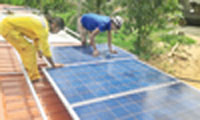
Nochchiya solar village gets water and revenue
Solar roofs: Work in progress to install solar panels in the dry zone village of Nochchiya
The first stage of a large solar village project at Nochchiya village-cluster in the Kurunegala district has been completed, with the installation of two solar power systems funded by UK-registered charities – The Association of Professional Sri Lankans in the UK (APSL) and Hela Sarana.
The Hela-Sarana-funded system was dedicated in memory of Raja Meehitiya, founder President of Hela Sarana who passed away in June 2015.
Nochchiya will be the second large village cluster to benefit from the solar village concept in Sri Lanka, the first being Kaduruwewa in the Kurunegala district, where the concept was launched in 2008.
The solar village project concept was designed and developed by Prof. I.M. Dharmadasa, in the late 1990s to empower rural communities using clean energy technologies for sustainable development and poverty reduction. Poverty reduction programmes in any community should have two main features; wealth creation methods and follow-up methods for job creation within the community.
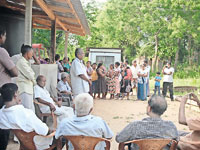
Community spirit: Nochchiya villagers hold a meeting to mark the completion of the first phase of the project
Two solar roofs of 3 KW each were installed in the village with the funding provided by the two charities. The cost of each system was Rs. 830,000 (£4.500). The power produced from 6 KW solar roofs will be fed into the national grid, and the income generated will be used to cover the cost of two water pumping stations that would be operated using grid electricity. The revenue will be managed in a fully transparent way by the Village Development Committee with guidance from project initiators. The project team will monitor the performance of the two solar roofs.
The water pumped and purified is mainly used for drinking by more than 1200 people in this village thereby preventing any kidney or water related diseases. The purified water is also available to seven surrounding villages. They can buy it at a nominal price. The project team within the APSL-UK is guiding the community to achieve rapid economic development applying the solar village concepts.
The project also fulfils 13 of the 17 SDGs (Sustainable Development Goals) of the United Nations, and is also highly relevant to Sri Lanka as it supports the Government’s recently launched “Soorya Bala Sangramaya” (Battle for Solar Energy) programme.
Source – 05 /03/ 2017 , The Sunday Times, See more at – http://www.sundaytimes.lk/170305/sunday-times-2/nochchiya-solar-village-gets-water-and-revenue-231497.html
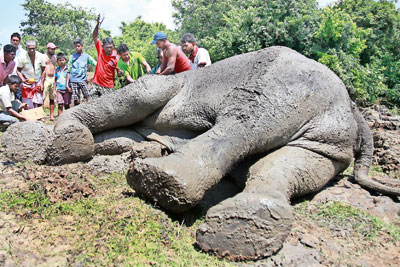
Deadly garbage dumps pose elephantine problems
By Malaka Rodrigo
Agonising death: The elephant which died after suffering for more than a month after eating garbage at Manampitiya. Pic by Karunaratne Gamage
An elephant which had been regularly eating garbage at Manampitiya died last Saturday after suffering from a sickness for a month.
This well grown male, about 20 years of age, was part of a herd that fed on garbage from a dump at Manampitiya. It had fallen ill in the third week of January. A veterinary surgeon and a team of wildlife officers tried to flush out any non-digestive materials from its stomach. One even inserted a hand through its anus to manually pull anything that remained. At first they pulled out about 15 kilograms of polythene in a day and over a month about 30 kilograms were removed.
Dr Pramuditha Devasurendra who had treated the elephant, rejected the idea that the polythene was the cause of death. He said toxic bacteria in rotting food may have been the cause. “The garbage pit contains lots of lunch sheets with rotten food. Deadly bacteria can grow on the food. This is main reason for the death of the elephant.”
Dr Devasurendra revealed that a post-mortem did not find any polythene in the bowels of the dead elephant. Its liver and spleen were damaged.
He said he had treated another elephant about half a kilometre away from the garbage dump at Manampitiya. “That elephant too died and I have been unfortunate to witness deaths of at least 10 elephants since I assumed duties in this area four years ago,” Dr Devasurendra said.
The Manampitiya dump is not the only one that attracts elephants. A garbage dump in Dambulla attracts elephants. Yet another dump in Hambantota is protected by an electric fence.
Dr. Devasurendra said an electric fence was needed at Manampitiya.
Meanwhile, Dr Prithiviraj Fernando, estimates that there are at least 50 locations where elephants come to forage at the dump. They are mostly in the dry zone.
Dr Fernando said piles of vegetables, over ripe fruit, flour, rice, bread and the like are more nutritious than what is found naturally. Elephants which rummage for these at the dumps are in better health, he said.
But he said every day 500 elephants may be eating garbage. “In a year, how many of them would die as a result? How does this compare with other ‘unnatural’ causes of elephant deaths? Such as being shot, hakka patas, injuries from trap guns and nooses, train or vehicle accidents, starving to death inside parks after being driven in and restricted with electric fences,” he asks.
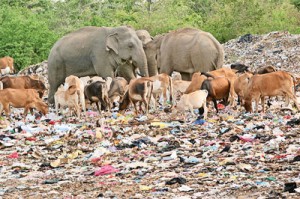
This also means the elephants are not raiding farms. So if they are to be prevented from raiding garbage dumps would it increase the human elephant conflict, and how many of them would be injured and killed? And how many people would be injured and killed? Dr Fernando asks.
“So before jumping in and trying to ‘fix’ something one should first find out what the problem is, figure out the cost and benefit of ‘fixing’ and make an informed decision. Otherwise the cure may be worse than the disease,” he warns.
Dr. Fernando suggests separating the organic matter from the plastics, metals, and glass materials before being dumped.
Source – 05/03/2017 ,The Sunday Times , See more at – http://www.sundaytimes.lk/170305/news/deadly-garbage-dumps-pose-elephantine-problems-231517.html
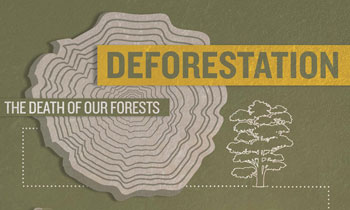
Deforestation in SL decreased by 0.4 per cent in past decade: UN
According to the report issued by the Food and Agriculture Organization (FAO) of the United Nations, deforestation in Sri Lanka has decreased to 0.4 per cent during the past decade, Conservator General of Forests Anura Sathurusinghe said yesterday.
Mr. Sathurusinghe told the Daily Mirror that the FAO report, issued every five years, has rated Sri Lanka as a country with less deforestation during the period of years 2000 – 2010. “During the past decade (2000-2010), the deforestation in the country has decreased to 58, 791 hectares of forest land, which was rated as 1.3 per cent as against 104, 380 hectares during the period 1990 – 2000. At present the FAO has rated Sri Lanka as a country with minimum forest cover,” he said.
Meanwhile, he said they had decided to launch an web portal to detect the places where deforestation was prevalent around the country. “The website will be launched in the coming month. Any person who has information of deforestation taking place in their areas can inform us so that we can investigate it,” he said, adding this would help immeasurably to control deforestation in the country. (Kalathma Jayawardhane) –
Source – 03/03/2017 ,Daily mirror ,See more at: http://www.dailymirror.lk/article/Deforestation-in-SL-decreased-by-per-cent-in-past-decade-UN-124891.html#sthash.ftdFkKYF.dpuf
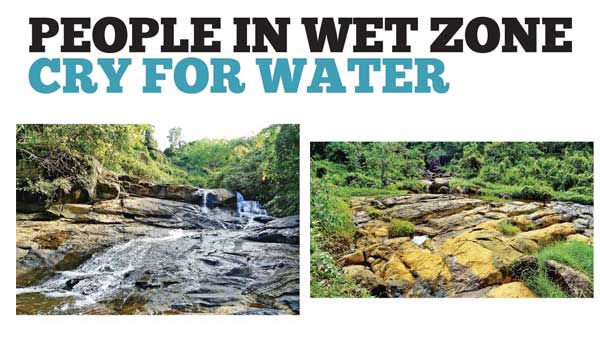
People in wet zone cry for water
By Wasantha Kumara and
Kulasiri Amarasinghe
Kalutara is a wet zone district with 26 waterfalls and streams. But today thousands of people in the Kalutara District are waiting for the water bowser to meet their requirements.
The people in the Kalutara District rarely experienced any drought. Instead, floods devastated the district several times a year. It is said that the people who over exploited natural resources are now reaping the harvest.
The Water Resources Board and environmentalists urge the people to use water from streams and even the wells carefully because most of the water resources in the district are drying up.
There are 26 well-known waterfalls in the Kalutara District. Some of them are Makeliya Ella, Athwelthota Ella, Thambadola Ella, Thudugala Ella, Ginigedara Ella, Ahas Bokku Ella, Thotas Ella, Kapuru Ella, Peelithudu Ella and Raja Meruna Ella. There are 10 other unidentified waterfalls too, which nourish the Kalu Ganga.
Kalu Ganga
In addition to the main river Kalu Ganga, nine sub rivers, namely Bolgoda, Magura, Pelanda, Kukuleganga, Athwelthota Ganga, Benthara Ganga and Panadura Ganga also flow across the district.
There are several forest reserves such as Kalugala, Runakanda and Yagirala which have a wide bio-diversity, but threatened by humans. They are formerly part of the Sinharaja rain forest.
All the streams, waterfalls and forest reserves are now threatened due to human activities.
The Kalutara District was famous for rubber plantations. Even the Sri Lanka Rubber Research Institute is situated in Agalawatta.
However, the Kalutara District has been invaded by oil palm cultivation which dries up the soil.
Illegal sand mining
The Kalu Ganga is severely affected by the illegal sand mining. The river bed has been deepened and the banks have been washed away. This has led to the destruction of mangrove swamps. During droughts, salt water flows upstream about 10 kilometres. The water purifying plant in Kethhena provides water to people in areas such as Kalutara, Dodangoda, and Wadduwa.
Today the residents in those areas are compelled to drink salty water. About 50, 000 residents on the river banks cannot use the water for their day-to-day activities.
Sea water flowing upstream started about 50 years ago, the residents of the river valleys say. None of the efforts taken by the authorities succeeded to stop it.
The District Secretary of Kalutara said 411 water tanks have been put up and water is distributed using bowsers by the Water Supply and Drainage Board to 500, 000 members of 63, 000 families with the help of the Disaster Management Centre and the Army.
Human activities
Environmental organizations say the human activities have led to the drying up of water resources. Replacing rubber with oil palm has also been identified as a reason for drought. Closing the gate only after the horse has bolted, the District Coordinating Committee banned the expansion of oil palm cultivation only last month. However, Apehanda Environmental Media Organization has alleged that the existing cultivation of palm oil is sufficient for drying up the land.
The Secretary of the organization Nandana Ariyathilaka said unregulated sand mining in the Kalu Ganga is a more serious problem than oil palm cultivation.
The Regional Manager of the Water Supply and Drainage Board Kamal Senevirathna said the environmental impact report of a new project to prevent sea water flowing upstream had been submitted and it would be implemented soon.
The river bed deepening of the Benthara Ganga has adversely affected 18, 000 acres of paddy lands in Walallawita and Aviththawa.
Tube wells
It was revealed at the District Agricultural Committee of Kalutara that only one of 25 tube wells dug in the 1980s and 1990s still operate. Two third of the water resources in the district are not registered under the Water Resources Board.
The District Secretary has directed the Grama Niladharis to document the water resources in the remote areas and take measures to protect them.
The Kalutara District was resilient even to six months of drought in the past, but now it cannot endure a week of drought. All water sources have gone dry. But three days of rain will cause floods again.
In all the 14 divisional Secretariat areas – hundreds of acres of paddy fields and marshlands have been reclaimed for constructions. Clearing and plotting of land for sale has dried many lands.
Massive granite mining takes place in areas like Neboda, Matugama, Narthupana and Wellatha areas ignoring the concerns of environmentalists and even law enforcement officers. Most of the quarries are in the mountains which are the water resources.
Dry weather
Meanwhile the tea small growers and planters say the situation has threatened the tea cultivation as well. The District Manager of Tea Small Holding Authority D.M.J. Nakandala said the dry weather had affected the tea cultivation. Temperature of 18-25 celsius is necessary for tea cultivation but the present temperature in Matugama and Agalawatta areas is 32-35 celsius. Nakandala said the trend of increasing temperature would adversely affect the tea cultivation.
Not only humans but also land animals and fish are affected due to the prevailing drought. Many varieties of living beings in the district are now extinct. An environmentalist of Runakanda Bio Diversity Friends Organization Lalith Pushpakumara said the fish varieties known as Bulath Hapaya, Dankola Pethiya, Rathu Waral Pethiya, Hora Pandiya, Gal Pandiya, Puwakbadilla, Iri Ankutta, and Hal Mal Dandiya are already extinct.
Birds like Sudu Redi Hora, Kaha Kurulla, Mal Kurulla, Bata Ati Kukula, Pulli Wal Avic-hchiya, Maha Kerala, Lanka Pilalichcha, and Panduwan Bassa are severely threa-tened. Likewise some animals and plants like orchids are also threatened.
Soon the people will really understand the seriousness of the environmental degradation taking place in the Kalutara District, he said.
Source – 02/03/2017 ,Ceylon Today, See more at – http://www.ceylontoday.lk/print20170101CT20170331.php?id=16269
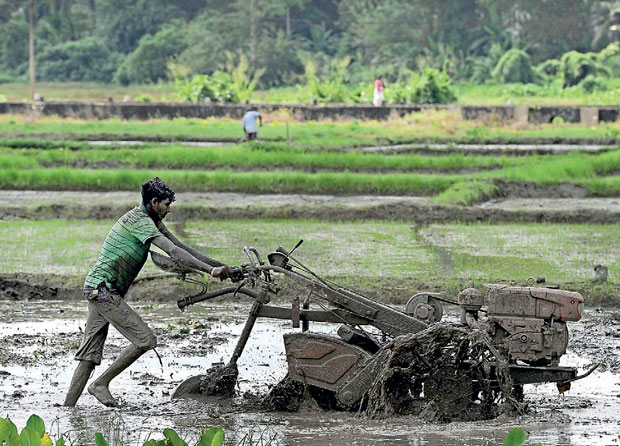
Agricultural livelihoods in Sri Lanka impacted by salinisation
Agriculture is one of the main sectors impacted by the impacts of climate change and its effects are very much felt due to the dependency on the natural resources that this livelihood has. Among the impacts on the agriculture sector are the impacts of the slow onset events of climate change.
Under the Cancun Adaptation Framework, the Parties to the United Nations Framework Convention on Climate Change (UNFCCC) recognized the impact of the slow onset events in the context of loss and damage.
The slow onset events formulate part of the climate change-induced extreme weather events that evolve gradually from incremental changes occurring over many years or from an increased frequency or intensity of recurring events. The slow onset events or slow onset processes, hazards or impacts are listed by the UNFCCC as sea level rise, increasing temperatures, ocean acidification, glacial retreat and related impacts, land and forest degradation, loss of biodiversity, desertification and salinisation. Affecting the people over a long period of time, the slow onset events have wide-ranging implications on food security, health and livelihoods of people, particularly in the agricultural sector.
What is salinity?
Salinity is the presence of soluble salts in soils or waters – a natural process which is accelerated and aggravated due to anthropocentric activities and due to the impacts caused by climate change, defined under the slow onset processes. The UNFCCC has recognized two causes for salinisation: the increasing evaporation due to the rising temperatures and the saltwater intrusion into coastal aquifers as a result of the increased evaporation and sea-level rise or flooding. With the increased accumulation of salt or sodium in the soil and water, particularly in arid environments, salinisation affects the soil structure causing soil degradation, soil erosion and lack of water retention, which adversely affect the agriculture-based livelihoods. Saline soils, which contain large amounts of water-soluble salts, hinder seed germination and plant growth, thereby reducing crop yields.
The coastal areas contribute to the country’s economy and almost a third of the country’s population is concentrated along the coastal belt. With the increasing incidence of extreme and slow onset events such as sea-level rise and inundation, the coastal and low-lying areas are particularly vulnerable to salinisation. The land degradation due to salinity in Sri Lanka is about 223,000 hectares of the total agricultural land area in the country.
Farmer stories from Morawewa
SLYCAN Trust as part of its research work focuses on the areas of Morawewa and Athabendiwewa in the Trincomalee District. During the field visits to these villages, the organisation has interviewed the farmers whose agriculture land is impacted by salinity. During the course of the visit and in the follow-up interviews with the farmers, it was made clear that salinisation is a real impediment faced by the farmer communities of the region. The farmers we interviewed were mostly dependent on agriculture for livelihood and the land dedicated to paddy cultivation was affected by salinisation.
The farmers also indicated that there were changes in the crop with discolouration in the plants and grains of rice. Many farmers have indicated that even if they are able to carry out agricultural activity on the affected lands, there are other impacts that reduce the price of the crops. Salinisation therefore could be seen as having a major impact on the quality of the crop and the quantity, given the decreased crop yield. Moreover, soil salinity affects the water sources and irrigation system in this area and in turn contributes to the problems faced in agriculture.
Through research conducted in the area, it was also revealed that the crop yield from an acre of agricultural land was affected on an average by a 50 percent reduction of crop yield. The farmers emphasized that the discolouration of the grain of rice and noticeably the lesser weight, result in having to sell rice at a lower price.
What causes soil salinity?
According to the farmers, one of the possible reasons for increased soil salinity is the increase in temperature resulting in higher amount of evaporation and lack of rain resulting in lesser water retention in the soil and also human activity.
One farmer in Morawewa-North expressed that salinity had affected his crop yield as well and that he has used organic fertilizer and seen improvements in the yield of crops. Similarly, the farmers of the area are considering an experimental shift to climate smart agricultural practices, which would lessen the impacts on the natural nutrient of the soil.
Addressing soil salinity
Using local knowledge, the farmers have tried to find solutions to the issue of soil salinity. Some of these include using paddy husks and ginisiriya (Gliricidiasipium) as a way to desalinise the land. The farmers indicated that leaving the residue of the paddy in the field after the harvesting process helped control the salinity problem to a certain extent.
Even though this seems to be a long-term solution, a farmer in the Morawewa North area attested to the use of dried cow dung and paddy husk as a continuous and long-term method of reducing soil salinity. He said that it took him around seven years to tend to a plot of three acres, one acre of which was affected by salinity, in order to render the soil that could be cultivated.
The slow onset events, as seen in salinisation encountered by the farmers in the Trincomalee area, have socio-economic implications on the lives of these communities. With the increasing incidence of weather events such as drought, the prolonged effects of salinisation are aggravated, further affecting the capacity to cultivate these agricultural lands.
Research, resilience building and capacity building in terms of developing solutions to the salinisation issue are seen as urgent action to be taken. The process of developing policy and climate solutions for salinisation should be focused on and such knowledge disseminated among the farmers, so as to help them address the impacts of salinity that create losses and damages to their agricultural activities.
(Avanthi Jayasuriya works as Programme and Communication Officer at SLYCAN Trust. She holds a degree specialising in English from the University of Colombo and is currently focused on her postgraduate studies in developmental economics. Her research interests include climate change, animal welfare, gender studies, economic development, transitional justice and peace studies)
source – 15/02/2017 , Daily Mirror, See more at: http://www.dailymirror.lk/article/Agricultural-livelihoods-in-Sri-Lanka-impacted-by-salinisation-123819.html#sthash.4BejY58V.dpuf
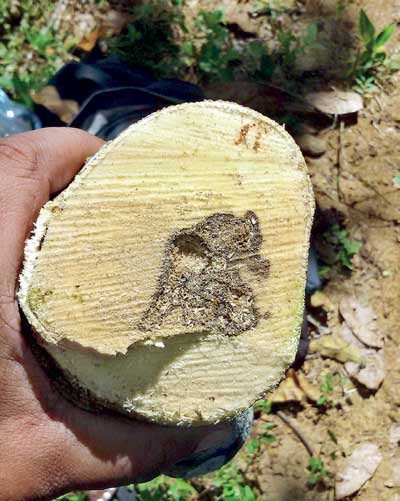
Achieving a sustainable future through commercial forestry
Although Sri Lanka is very rich in natural resources including a significant amount of natural forests, their utilisation should have been restricted for the sake of conservation so that the generations to come in future can utilise them in a sustainable manner. However, strict conservation does not generate a considerable financial return for the country’s economy and therefore looking for alternatives while protecting the environment and soil has become a priority.
In such circumstances, an achievement of the financial goals through commercial forestry can be sought as one of the viable investments in today’s economic platform. Thereby one can also reap the benefits from exporting the timber or non-timber forest products while preserving the country’s environment.
Considering the demand in the international market for some forestry-based products, one could easily earn a higher return on investing in proper forestry-related activities. This inevitably becomes investing in a greener future, conservation of nature and biodiversity of Sri Lanka. The main objective of commercial forestry, which was implemented in 1950, was to fulfil the timber requirement of the country. Due to the high demand of timber in the local market, plantation owners have not been able to export timber to fulfil the international requirements. Low pricing of timber in the local market is the biggest issue in the forestry industry in the country.
In contrast, high market opportunity has been opened up mainly for non-timber forest products such as sandalwood and agarwood in the international market. Agarwood at present is considered to be the most viable investment in the non-timber forest products sector, which could generate shorter turnaround time of harvest, becoming popular as a green investment in today’s economy. In contrast to the biggest challenge that the timber industry faces due to the long turnaround time, which could be over 15 to 20 years to extract timber to earn profits, non-timber forest products such as agarwood would be able to reduce the turnaround period considerably.
Recently, the leading perfume manufacturers in the world recognized agarwood oil as a base to formulate perfumes. Therefore, the demand for agarwood oil has now spread from the Middle-East market to the European market showing an increased growth on demand-over-supply. It is therefore becoming a viable investment opportunity.
Analysing the global demand statistics for agarwood-based by-products, at present the Far East Asian suppliers have only been able to fulfil 40 percent of the market demand. If the plantations of agarwood are raised and products are manufactured, the future export market of Sri Lanka will be highly benefitted.
In addition, the satisfaction gained by contributing to the conservation of nature by growing forests and preserving the valuable biodiversity will be immense. (Dr. Upul Subasinghe has been conducting research on forest management from 1995. Since 2009, he has been researching on non-timber forest products, especially on aromatic products such as agarwood and sandalwood. He is a Senior Lecturer at the Forestry and Environmental Science Department of the University of Sri Jayewardenepura specializing in Forest and Forest Plantation Management, Forest Certification and Natural Resource Modelling.
Apart from the publications in international journals and proceedings, he presented research findings at various international conferences including International Sandalwood Symposium in Hawaii, International Scientific Symposium on Agarwood in Malaysia, International Conference in Agarwood in Taiwan and International Seminar on Sandalwood in Bangalore, India)
Source – 01/03/2017/ Daily Mirror ,See more at: http://www.dailymirror.lk/article/Achieving-a-sustainable-future-through-commercial-forestry-124675.html#sthash.HuRZTjXX.dpuf

Drinking water is high priority say civil engineers
Civil engineers have noted that the country at present faced issues with regard to sustainability and technology when it came to water treatment for the purpose of producing drinking water.
Systems for the purpose of measurement must also be created in relation to water testing, specifically for testing of heavy metals, organic compounds, carbonic waste and priority organic pollutants, the mere presence of minute traces of which are carcinogenic in effect.
Senior Lecturer at the Department of Civil Engineering of the Faculty of Engineering of the University of Peradeniya, Dr. K.B. Shameen N. Jinadasa explained that appropriate technologies in terms of technologies which were economically, socially, environmentally, culturally, institutionally, administratively and structurally appropriate were not selected and used.
“There are lacunas in this process”, he said.
Another issue is that the systems pertaining to the above are installed separately, according to Jinadasa.
“The country must look at producing and manufacturing membrane filters locally”, Jinadasa further said.
“We should not have to depend on others with regard to membranous filters. When such filters are used in treatment related facilities, and the membrane of the filter breaks, we have to go to the country from which it was imported (China or Japan) or consult an expert in this regard. We must instead find a way to repair them here. We are conducting surveys to look at our weaknesses. This is a long-term process. For self-sustainability, we need a strong foundation and a suitable environment”. (RLJ)
Source – 31/12/2016, Nation, See more at – http://nation.lk/online/2016/12/31/drinking-water-is-high-priority-say-civil-engineers.html
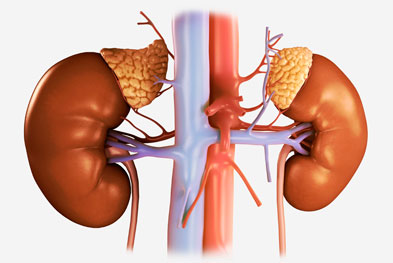
Impure water takes a toll in Uva
There has been an increase reported in the number of patients suffering from chronic kidney disease of unknown etiology (CKDu) in the Uva Province in areas such as Mahiyanganaya and Girandurukotte.
The relevant authorities are conducting blood tests with the view to identifying those who have yet to be identified as patients suffering from CKDu.
Governor of the Uva Province, MP Jayasinghe pointed out that people in mountainous and hilly regions in the Province were using water which naturally flowed in from such areas where water has contained traces of fertilizer and agrochemicals.
Rideemaliyadda, Moneragala, Badulla, Wellawaya and Diyatalawa are also similarly impacted, according to Jayasinghe.
“The agricultural industry is found in areas such as Welimada and Uva Paranagama which are populated by farmers and farms including jungle (Chena) cultivations where vegetables such as potatoes are grown,” Jayasinghe said.
He pointed out that certain residents lacked the economic essentials to obtain clean water while others were ignorant about the importance of using clean water and how to purify water while addressing issues pertaining to clean water.
Jayasinghe explained that moves to introduce dialysis units and machines for use in domestic settings in houses are presently at a discussion stage.
Source – 14/01/2017, Nation , See more at – http://nation.lk/online/2017/01/14/impure-water-takes-a-toll-in-uva.html













